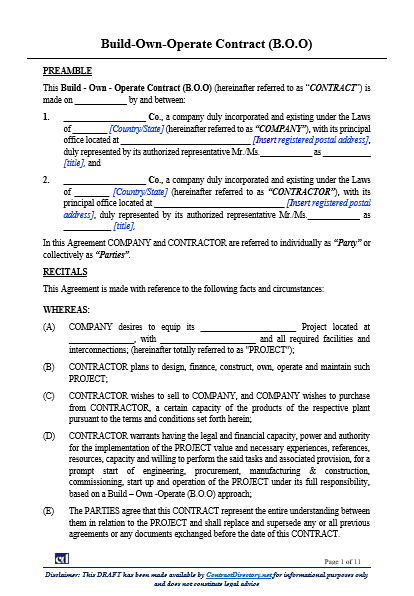Estimated reading time: 3 minutes
Introduction
A Build–Own–Operate Contract (B.O.O.) is a contractual framework where a private entity finances, constructs, owns, and operates an infrastructure facility indefinitely. Unlike Build–Operate–Transfer (B.O.T) projects, ownership of the asset does not revert to the government after the concession period. This structure has become a vital tool for infrastructure development, particularly in energy, utilities, and transport sectors.

Structure and Characteristics of B.O.O. Projects
Under a B.O.O. arrangement, the private sponsor assumes full responsibility for financing, designing, constructing, and managing the project.
Revenue is typically generated through user charges, long-term offtake contracts, or regulated tariffs. Because ownership remains private, the developer bears a higher share of operational and market risks — but also retains long-term profit potential.
Governments often use Build–Own–Operate Contract models when they wish to avoid public debt accumulation or asset ownership obligations while still benefiting from private-sector efficiency.
In some jurisdictions, the government may provide support measures such as tax incentives, performance guarantees, or tariff stabilization clauses to enhance bankability.
Legal Framework and Government Role
The legal foundation of a B.O.O. project usually involves:
- A Concession Agreement defining land use and operational rights.
- Offtake or Power Purchase Agreements (especially in energy projects).
- Licenses and Regulatory Approvals for construction and operation.
Governments may enter into Sovereign Guarantees or Performance Bank Guarantees to ensure that payment obligations under the offtake contract are met.
The private entity is fully responsible for compliance with environmental and safety standards throughout the lifecycle of the project.
B.O.O. vs. B.O.T: Ownership and Transfer
The key distinction between B.O.O. and B.O.T. lies in ownership transfer:
- In BOT projects, ownership of the asset reverts to the government after the concession expires.
- In B.O.O. projects, the private entity retains ownership indefinitely, making it suitable for long-term industrial and utility investments.
While B.O.T. is often used in transportation, public facilities, or government-controlled assets, B.O.O. is preferred in power generation, oil and gas, and telecommunications, where continuous private ownership supports technological innovation and efficiency.
Benefits and Risks
Advantages:
- Encourages private capital participation in infrastructure.
- Reduces public-sector debt exposure.
- Promotes efficiency and innovation through sustained ownership.
Risks:
- Limited government control over essential assets.
- Potential regulatory and tariff disputes.
- Long-term exposure to market demand and price volatility.
Balancing public interest with investor returns requires clear contractual terms and robust legal oversight — especially regarding pricing mechanisms and termination clauses.
See Also The Related Templates
Related Agreements and Templates associated with Build–Own–Operate (B.O.O) frameworks include:
- Private-Public Project Agreement (PPP)
- EPCF Contract (Engineering, Procurement, Construction & Finance)
- Build-Lease-Operate-Transfer Agreement (BLOT)
References (2023–2025)
- World Bank Open Knowledge Repository (2024). Infrastructure Monitor 2024.
- OECD Library (2024). Multilateral Development Finance 2024 Report.
- Asian Development Bank (ADB) (2023). Public–Private Partnership Handbook (Updated Edition).
- IMF Fiscal Policy Division (2025). Fiscal Risk Toolkit.
- Global Infrastructure Hub (2024). Private Participation in Infrastructure Database.
has been added to your cart!
have been added to your cart!



